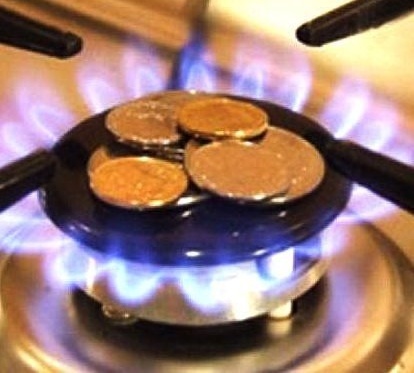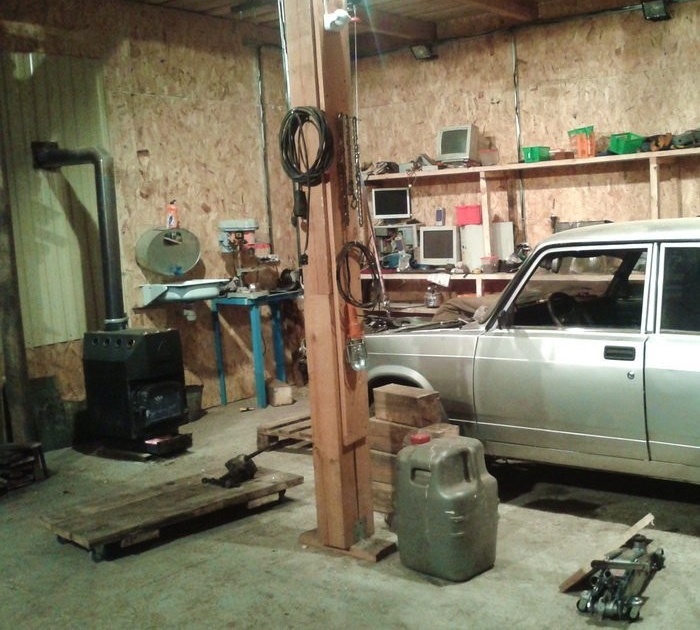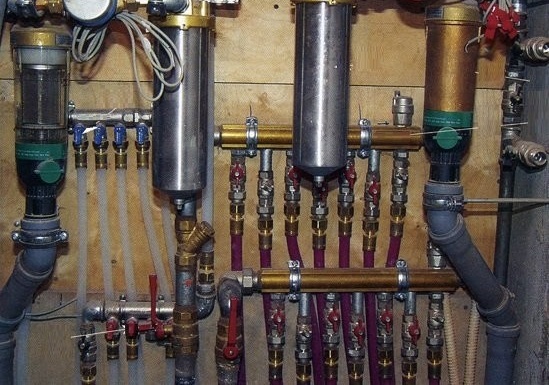Autonomous heating in an ordinary apartment: how to stop depending on heating systems
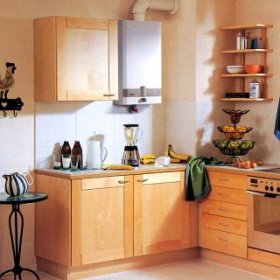
A private house with an individual heating boiler is a completely common phenomenon. Given the rising cost of utilities and the quality of heat supplied centrally, residents of apartment buildings also began to seriously think about how to install autonomous heating in the apartment. Realizing this idea is more difficult than equipping a detached cottage with a heating system, but still it is quite possible. Read on and we will explain in more detail how to do this.
Content
Possible problems you will encounter
With a private home, everything is relatively simple. Here you can put a gas, solid fuel, liquid fuel or electric boiler, make a water heated floor, arrange a solar heating collector on the roof, install solar panels, use one of the types of heat pump, make a combination of these methods and even build a separate building for the boiler room.
In an apartment building, most of these methods are not possible because:
- this may harm the interests of other residents;
- not every project can be implemented in an apartment from a technical or practical point of view;
- There are many legislative restrictions, etc.
For example, it makes no sense to put in an apartment solid fuel boilersince significant storage space is required for fuel storage, and usually the ceiling is not designed for such weight gain. Of course, storing a large amount of flammable liquids in such a situation can be dangerous. It is forbidden to install in apartment buildings water heated flooronly allowed him electric variety.
Sometimes, with the transition to individual heating, problems arise not of a technical, but of a legal nature. In some regions, the rejection of district heating may be prohibited by law. In such a situation, one should start not with the design of technical documentation, but with the consultation of a lawyer. Perhaps the apartment owner will have to seek permission from the court to disconnect from the central heating system, as well as obtain permission to install individual heating equipment.
Most often in apartments use two options for autonomous heating: gas or electric. In the first case, the installation is considered the best choice. double-circuit gas boiler. Electricity is used to heat the coolant not only directly, but also indirectly, for example, to work heat pump. Whatever the choice, you will have to take into account the need for preliminary dismantling of the old heating system, since it is far from always possible to use the old pipes and radiators.
An interesting option for switching to electric individual heating is presented in the following video:
Option # 1 - gas heating (column)
For the apartment, a modern double-circuit gas boiler, equipped with a closed combustion chamber, electronic ignition and equipped with a programmable thermostat, is perfect. This configuration will help maintain optimal temperature in the system. coolant for different times of the day. It is recommended that owners of a spacious apartment acquire a storage boiler, this will allow them to stock up with plenty of hot water so that you can simultaneously wash the dishes and take a shower.
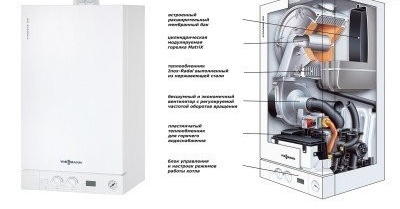
The diagram shows the device of a double-circuit gas boiler, which is optimally suited for the installation of autonomous heating in an ordinary apartment
Advantages and disadvantages of this option
The degree of automation of modern gas boilers is quite high; after installation and configuration, the equipment can work completely autonomously. Security systems minimize the risk of gas leaks and other unpleasant consequences. For small apartments you can always choose a compact boiler model, which does not take up much space. The boiler runs silently, it will not disturb either the residents of the apartment or their neighbors. Prices for such equipment vary in a wide range, which allows you to choose the right option at the best price.
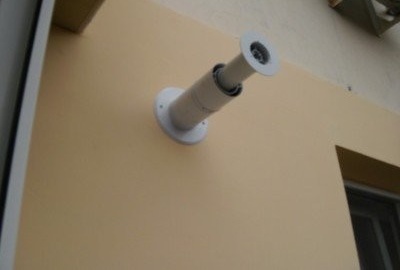
For installation of a dual-circuit gas boiler with a closed combustion chamber on the facade of a building of a coaxial chimney, special permission may be required
It is worth considering the disadvantages of such a solution:
- No matter how small the probability of a gas explosion, it still exists.
- The ventilation system in the room where the gas boiler is installed must meet the highest requirements.
- The cost of domestic gas for the population is steadily increasing.
- The ventilation ducts will require periodic cleaning, as they will become clogged with greasy soot - the products of the combustion of domestic gas.
- Using coaxial chimney an unpleasant smell will penetrate the apartment through an open window.
It is also important to note that for the installation of the coaxial chimney outlet on the front of the building, the permission of the supervisory authorities may be required.
Features of the gas system
Installation of gas heating equipment is carried out in four stages:
- Installation of a gas boiler.
- Shutdown and dismantle of the old heating system.
- Installation of radiators and heating pipes for the new system.
- Connection of a gas boiler.
To implement the last stage, you should invite a specialist from the gas service, who will monitor compliance with all operating rules and safety regulations.
Insofar as sudden water hammer in an autonomous heating system are practically excluded, pipes and radiators can be selected without increased strength requirements. Most often, apartment owners choose light aluminum radiatorsthat have enhanced heat dissipation. Easy to install and resistant to corrosion, 20 mm polypropylene pipes are perfectly suited to them. For heating systems and hot water supply, PP pipes reinforced with foil are recommended, which compensates for the high thermal expansion characteristic of polypropylene.
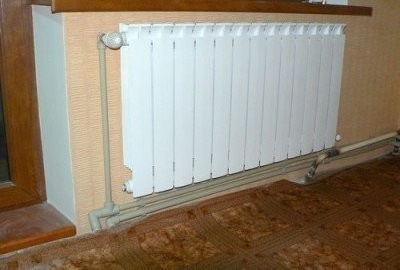
For autonomous heating in an ordinary apartment, light aluminum radiators with good heat dissipation and polypropylene pipes are best suited
During the installation of radiators and pipes, a number of rules should be followed:
- Radiators should be connected to the circuit in parallel, and not in series.
- When inserting radiators, you need to use the diagonal pattern (top to bottom).
- A thermal head should be installed on the return wiring of each radiator.
- In the upper plug of each radiator, it is necessary to put a Mayevsky tap.
- A valve must be installed on the radiator feed.
- Installation of radiators is carried out strictly according to the level.
- Clamping clips are required on the spill to compensate for the thermal expansion of the pipes.
- At the end of the installation of pipes and radiators and before connecting the boiler, it is necessary to pressure test the system.
For the normal functioning of the autonomous heating system, a circulation pump is necessary, as well as elements of the safety group:
- expansion tank;
- pressure gauge;
- safety valve;
- device for automatic air exhaust.
Usually modern gas boilers are already equipped with all these necessary elements and are completely ready for use.
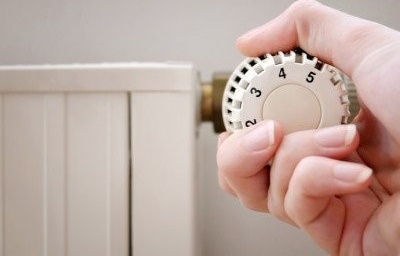
The thermal head on the heating radiator will allow you to adjust the temperature in the room, and the gas boiler control system will maintain the necessary temperature of the coolant
Option # 2 - Electric Heating
The owner of the apartment has several options for heating with electricity:
- electric boiler;
- warm floor;
- Heat pump.
The first two options can be quite expensive during operation, since electricity is constantly becoming more expensive, like other energy carriers. For installation electric boiler, as with the installation of gas, you will need to remove the old pipes and radiators and install new ones. Underfloor heating system considered more effective due to its features. When the heating elements are evenly distributed throughout the floor, and the air in the room warms up from the bottom up, less heat is needed to heat the room than with traditional heating with hot water.
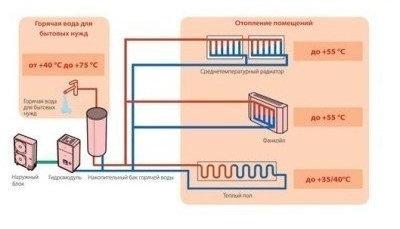
The diagram shows the options for connecting the air-to-water heat pump to different types of heating systems: radiators, fan coil, warm floor
The most beneficial for autonomous heating of an apartment is considered a heat pump of the type “air-water" or "air-to-air" In this case, electricity is used in relatively small amounts to operate equipment that extracts low-potential thermal energy from the environment and converts it into high-potential energy. A heat pump is an environmentally friendly heating method that uses a renewable source of thermal energy. But it is considered effective only in warm climatic zones, i.e. where the air temperature does not drop below -25 degrees.
The cost of air heat pump equipment can be quite high. Compared to the cost of individual gas heating, the unit of heat received during the operation of the heat pump is somewhat more expensive. However, in the long run, such a solution may be more profitable than a gas boiler. In addition, the air-to-air heat pump in the summer can act as an air conditioner. The operation of these devices is based on general principles, which is why the heat pump is sometimes called air conditioning.
To install an air heat pump in an apartment, you must select the appropriate model. Large channel systems are more suitable for apartments with a large area. In this case, you will have to install a central unit, from which warm air will spread through the ducts. In addition, the cost of equipment can be quite high. The multisplit system works in approximately the same way: a common unit is mounted outside, connected by highways with indoor units for each room.
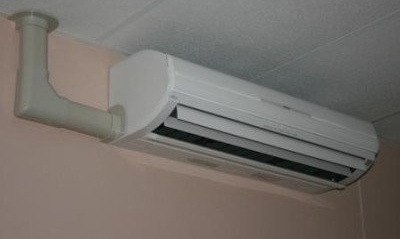
The indoor unit of the air-to-air heat pump is very similar to the unit of an air conditioner split system, since these devices operate on similar principles
In a small apartment, it makes sense to install a separate split system for each room. In this case, you do not have to lay a network of ducts around the apartment.This is very convenient if the finishing work in the apartment is already completed and major overhaul is not planned in the near future. The amount of heat for each kilowatt-hour of electricity used in multi-split systems is 3.5 kW or less. Inventor split system with one external and internal unit can produce up to 5 kW of heat.
In areas with harsh winters, some apartment owners use the combined option: in cold weather they use a gas boiler, and when it gets warmer, they turn on the heat pump. A combination of a heat pump and a warm floor may also be an interesting option.
